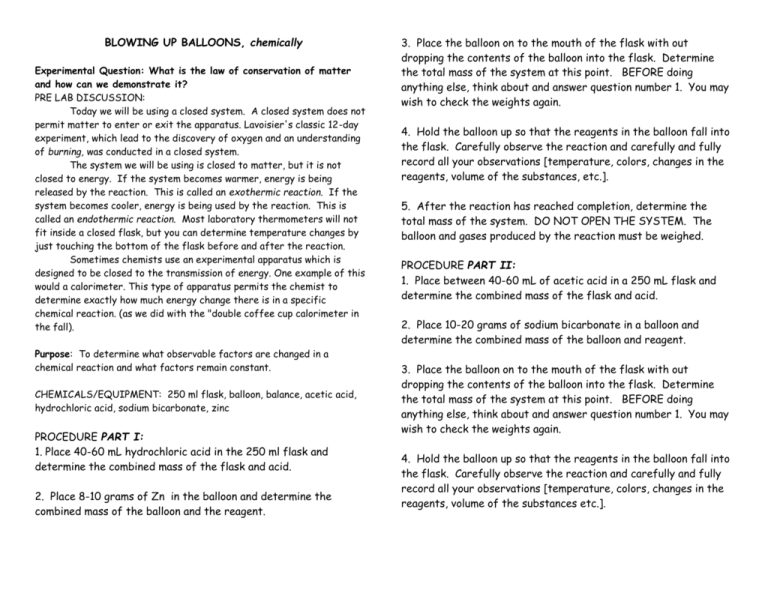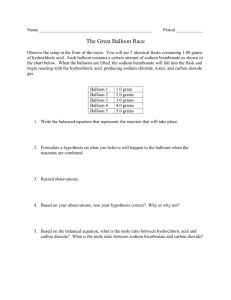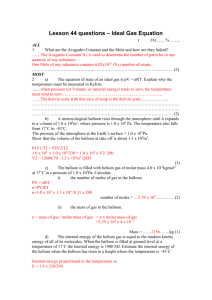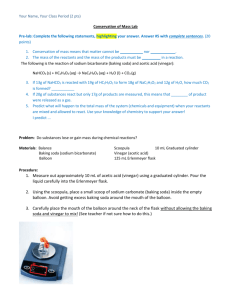File - HCDE Secondary Science
advertisement

BLOWING UP BALLOONS, chemically Experimental Question: What is the law of conservation of matter and how can we demonstrate it? PRE LAB DISCUSSION: Today we will be using a closed system. A closed system does not permit matter to enter or exit the apparatus. Lavoisier's classic 12-day experiment, which lead to the discovery of oxygen and an understanding of burning, was conducted in a closed system. The system we will be using is closed to matter, but it is not closed to energy. If the system becomes warmer, energy is being released by the reaction. This is called an exothermic reaction. If the system becomes cooler, energy is being used by the reaction. This is called an endothermic reaction. Most laboratory thermometers will not fit inside a closed flask, but you can determine temperature changes by just touching the bottom of the flask before and after the reaction. Sometimes chemists use an experimental apparatus which is designed to be closed to the transmission of energy. One example of this would a calorimeter. This type of apparatus permits the chemist to determine exactly how much energy change there is in a specific chemical reaction. (as we did with the "double coffee cup calorimeter in the fall). Purpose: To determine what observable factors are changed in a chemical reaction and what factors remain constant. CHEMICALS/EQUIPMENT: 250 ml flask, balloon, balance, acetic acid, hydrochloric acid, sodium bicarbonate, zinc PROCEDURE PART I: 1. Place 40-60 mL hydrochloric acid in the 250 ml flask and determine the combined mass of the flask and acid. 2. Place 8-10 grams of Zn in the balloon and determine the combined mass of the balloon and the reagent. 3. Place the balloon on to the mouth of the flask with out dropping the contents of the balloon into the flask. Determine the total mass of the system at this point. BEFORE doing anything else, think about and answer question number 1. You may wish to check the weights again. 4. Hold the balloon up so that the reagents in the balloon fall into the flask. Carefully observe the reaction and carefully and fully record all your observations [temperature, colors, changes in the reagents, volume of the substances, etc.]. 5. After the reaction has reached completion, determine the total mass of the system. DO NOT OPEN THE SYSTEM. The balloon and gases produced by the reaction must be weighed. PROCEDURE PART II: 1. Place between 40-60 mL of acetic acid in a 250 mL flask and determine the combined mass of the flask and acid. 2. Place 10-20 grams of sodium bicarbonate in a balloon and determine the combined mass of the balloon and reagent. 3. Place the balloon on to the mouth of the flask with out dropping the contents of the balloon into the flask. Determine the total mass of the system at this point. BEFORE doing anything else, think about and answer question number 1. You may wish to check the weights again. 4. Hold the balloon up so that the reagents in the balloon fall into the flask. Carefully observe the reaction and carefully and fully record all your observations [temperature, colors, changes in the reagents, volume of the substances etc.]. 5. After the reaction has reached completion, determine the total mass of the system. DO NOT OPEN THE SYSTEM. The balloon and gases produced by the reaction must be weighed. Record the following in your lab book. ======================================================= DATA (include units!) PART I 1. Mass of flask and HCl 2. Mass of balloon and zinc 3. Total Mass 4. Mass of flask, acid, balloon, & zinc before reaction 5. Mass of flask, acid, balloon, &zinc after reaction Changes observed in the system I as it reacted PART II 1. Mass of flask and acetic acid 2. Mass of balloon and NaHCO3 3. Total Mass 4. Mass of flask, acid, balloon, & NaHCO3 before reaction 5. Mass of flask, acid, balloon, & NaHCO3 after reaction Changes observed in the system II as it reacted THINKING SCIENTIFICALLY: Write the answers to these questions in your lab book using complete sentences. 1. Is the total mass of the chemical system (3) equal to the sum of the mass of (1) flask and acid plus (2) the mass of the balloon and reagents? Why or why not? 2. Compare the mass before the reaction and after the reaction? What trend do you notice? 3. Should we consider this a significant difference in the mass of the system after the reactants have formed the products? Why or why not? 4. Did the zinc and hydrochloric acid system take in energy [endothermic] or give off energy [exothermic] to the environment? How did you determine this? 5. Did the sodium bicarbonate and acetic acid system take in energy [endothermic] or give off energy [exothermic] to the environment? How did you determine this? 6. In each part, which had a greater volume, the reactants or the product? How do you know this? 7. Did the color of the liquid change in either reaction?________ If so, tell what color it was before, during, and after the reaction. 8. Did the color of the solids change in either reaction?_________ If so, tell the color before and after the reaction. 9. Did the texture, shape or form of the solids change in either reaction?________ If so, describe how they looked before and after the reaction. 10. Propose the common environmental gas that was formed in System I based on the starting substances. Defend your answer with evidence. 11. Propose the common environmental gas that was formed in System II based on the starting substances. Defend your answer with evidence. 12. This lab in theory demonstrates conservation of mass, but in fact, a little mass is lost. Which system lost more mass? Propose a logical reason why this system lost more mass. Conclusion: Write a brief paragraph that addresses the experimental question, states the law of the conservation of matter, and explains how it applies to this lab activity. You may be asked to share this with the class, so try to be clear and thorough. 2









